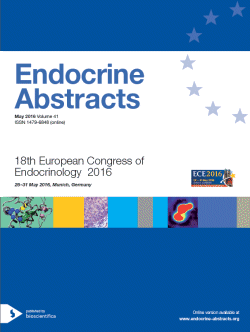Searchable abstracts of presentations at key conferences in endocrinology
ea0041mte1 | (1) | ECE2016
Gynaecomastia in adult men is frequently a symptom of other diseases; the Copenhagen experience
Breast development in boys and men, gynaecomastia, is a common condition. The incidence peaks three times through life: neonatally in the first weeks after birth; pubertally, usually around genital stage 3 to 4 and in adulthood with increasing incidence after the age of 50 years.Using a standardized diagnostic approach a cause for gynaecomastia developed in adulthood can be detected in the majority of men, and gynaecomastia may be the first presenting sy...
ea0041mte2.1-mte2.2 | (1) | ECE2016
Difficult thyroid cases
In clinical practice, most thyroid disease is due to thyroid gland dysfunction and so can be detected by measurement of TSH alone. This is because the negative feedback of thyroid hormones on the hypothalamus and pituitary gland result in TSH levels that are closely, and inversely, correlated with circulating free thyroid hormone (FT4, FT3) levels. However, several conditions are exceptions to this rule and can be very hard to diagnose also due to a certa...
ea0041mte4 | (1) | ECE2016
Treatment of osteoporosis; treatment goals and duration of therapy
Osteoporosis is a prevalent condition mainly involving the elderly with an increased risk of fractures, morbidity and mortality. Partly due to ageing of the population there is an increase in the prevalence of osteoporosis and fractures. It is estimated that one in five men will experience a fragility fracture after the age of 50 years. Apart from lifestyle factors such as increasing physical exercise, adequate status of calcium and vitamin D, the cessation of smoking and mode...
ea0041mte6 | (1) | ECE2016
MEN syndromes
Multiple endocrine neoplasia (MEN) syndromes are classically defined as the occurrence of two or more endocrine tumours in a patient, and include two major forms, characterized by development of tumours within specific endocrine glands, referred to as type 1 (MEN1) and type 2 (MEN2). These disorders are due to mutations in the MEN1 gene in MEN1 (parathyroid, pituitary or pancreatic tumours), and in the RET gene in MEN2 (which comprises three types: MEN2A with...
ea0041mte7 | (1) | ECE2016
New ATA recommendation for differentiated thyroid cancer management from the point of view of European endocrinologist
The American Thyroid Association has recently developed updated guidelines for the management of thyroid nodules and thyroid cancer. Compared to previous editions, this new guidelines give important new recommendation on several issues.Initial treatment for thyroid cancer is total thyroidectomy. After total thyroidectomy, patients are treated with 131I activities aimed at ablating any remnant thyroid tissue. Radioiodine ablation is recommended...
ea0041mte9 | (1) | ECE2016
Treatment of male hypogonadism
Traditionally, male hypogonadism is classified into hypogonadotrophic (the archetype being Kallmann syndrome) and hypergonadotrophic (the archetype being Klinefelter syndrome). Late-onset hypogonadism (LOH) constitutes a separate entity that can be defined as the state where men of advanced age demonstrate low serum testosterone (T) concentrations in combination with a spectrum of symptoms reminiscent of those of classic male hypogonadism (e.g. reduced sexual funct...
ea0041mte10 | (1) | ECE2016
Systems medicine: the impact on endocrine practice
Systems Medicine is an interdisciplinary field of study that deals with systems of the human body as part of an integrated whole, incorporating biochemical, physiological, and environment interactions. Systems Medicine draws on systems science and systems biology, and considers complex interactions within the human body with a patients genomics, behavior and environment perspective. The earliest uses of the term systems medicine appeared in 1992, it is a modern approach ...




